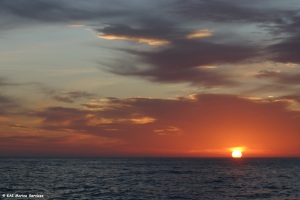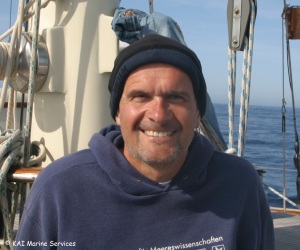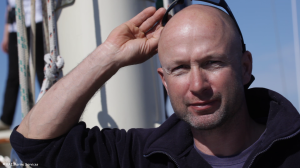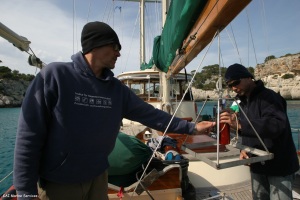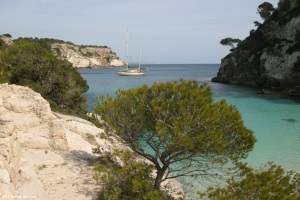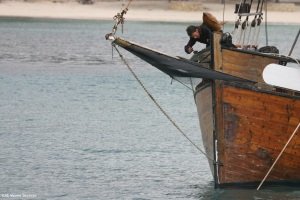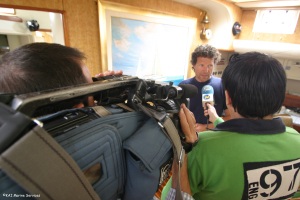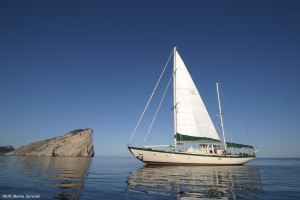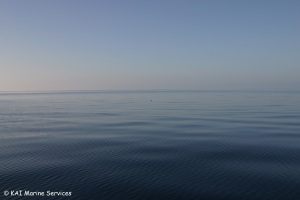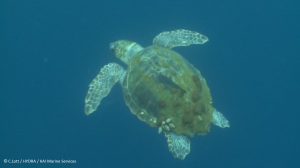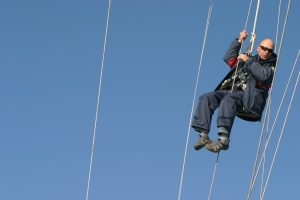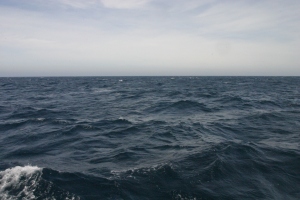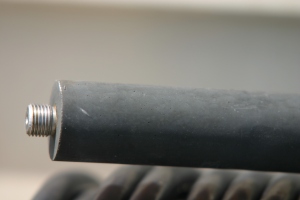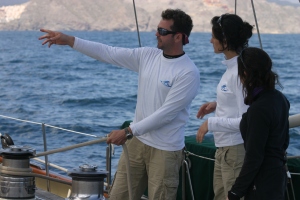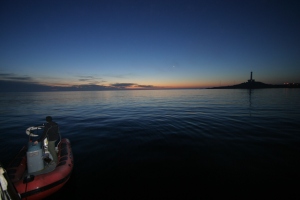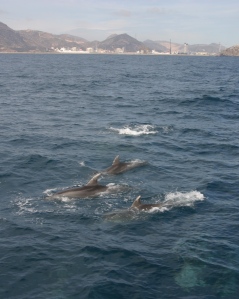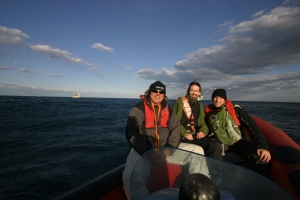Our month long expedition is unfortunately coming to an end. This week in Menorca has been a great success with deployments of the experimental lobster trap of Alnitak, developed with the technical support of the HYDRA Institute. Boris and Christian accomplished a robust innovative device that combines modern underwater filming technologies with traditional lobster catching methods, with the aim of improving the efficiency of lobster traps. We worked directly with Pedro Marqués, the only fisherman in the Spanish Mediterranean integrated in the “Slow Fish” network. The design is user friendly and utilizes affordable technologies allowing local people to set up the traps independently and benefit from them after we leave. This collaboration between KAI Marine Services, the OASIS project and the HYDRA Institute, allowed us to supporting traditional fishing methods, work with the community and help achieve long term sustainability.
Upon arriving in Mahon, we held another press conference, this time entirely on the boat, promoting the work achieved already by the OASIS project, our work over the last month and the exciting research to be continued.

A video of the OASIS project put together by Christian highlighting the research methods and the beauty of the Mediterranean marine ecosystems.
The last month has seen a unique team of international scientists collaborating together to the benefit of marine wildlife. During the first two weeks of April, a research team from KAI Marine Services, Alnitak, NOAA, Hopkins Marine Station and National Geographic worked in the southwest Mediterranean, where loggerhead turtles aggregate to feed during their transoceanic life cycles. The research NGO ALNITAK participates in this survey developing the loggerhead turtle tracking study in collaboration with National Geographic, in the context of the OASIS project funded by Fundación Biodiversidad.
We successfully deployed the latest model of National Geographic’s Crittercam®, the first deployment of Crittercams® on loggerhead turtles in the Mediterranean, which will allow us to study their diving and swimming behaviour, as well as interactions with their environment and other species. Working together with Boris Unger and Christian Lott from the HYDRA Institute, Franḉoise Claro, director of Groupe Tortues Marines de France from the Paris Museum National D’Histoire Naturelle, and Jeppe Dalgaard Balle, a bioacoustician from Denmark, we surveyed, set up and used hydrophones, took blood and skin samples and shot beautiful underwater footage of loggerhead turtles. This opportunity has been very unique; bringing together researchers from a variety of scientific backgrounds from across the world, which heightens international collaboration in science and benefits marine conservation.

The crew (with origins in Spain, Holland, Denmark, USA, France, Argentina, Belgium ad the UK) together on board the Luis Ginillo in Torrevieja.

Francoise and Ricardo working together to take blood and skin samples from the turtle Ella Maillart.
The benefits and outcomes of this project are twofold. First the benefit to scientific research, which enhances our understanding of loggerhead turtles and thus encouraging informed marine conservation management proposals and decisions. Loggerhead turtles originating from the nesting beaches off the east coast of the US enter the Mediterranean following the last meanders of the Gulf Stream to find ideal conditions for their first phase in life. They drift passively as small oasis aggregating algae, invertebrates and small fish. This “fish aggregating” effect is one of the main questions the Fundación Biodiversidad “OASIS Project” is looking at. For the conservation of sea turtle populations, the experiments to be conducted here are of special relevance. A better understanding of foraging, habitat use, diving patterns and sensorial biology should allow researchers to find new solutions to the threats of bycatch in fisheries, debris pollution and ship-strikes.
The second key outcome of this project is working directly and collaborating with local people to the benefit of both the community and the research. By collaborating with local fisherman in Torrevieja and in Menorca, as well as by holding local press conferences, the expedition stands out in its ability to link the world of applied science with the general public. Apart from scientific institutions, such as IMEDEA – SOCIB, IEO and the Hydra Institute, the project counts on the collaboration of the Spanish longlining fleet, the Spanish General Secretariat of Fishing and the fishermen association CEPESCA. Work in collaboration with this fishing sector dates as far back as 1986 and has recently solved the important problem of the bycatch of over 20,000 loggerhead turtles per year in this region occurring in the swordfish fishery.
KAI Expeditions is continuing to work with the general public and is offering volunteers a once in a lifetime experience this summer to become Jacques Yves Cousteau. Volunteers and interns are required to participate in the LIFE+ Migrate project in Malta, undertaking turtle and cetaceans surveys. Expeditioners will actively contribute to the design of marine protected areas in the Mediterranean and conduct research, which will develop tangible solutions to the challenges our marine environment is facing. You can learn more about this work and the volunteering program at www.kaiexpeditions.com.
Our last month has been a huge success for the OASIS project, bringing together scientists and crew members from over 10 countries, working with the local community and performing critical research on marine wildlife in the Mediterranean. This success could not have been achieved without the fantastic Luis Ginillo. The Luis Ginillo has not just been our office, but also our home. It has been the perfect platform for conducting research and we are very grateful for this unique experience of working and living on such an amazing vessel.
And finally, the people that have made this all possible…

Franḉoise Claro, director of Groupe Tortues Marines de France from the Museum National d’Histoire Naturelle in Paris.








